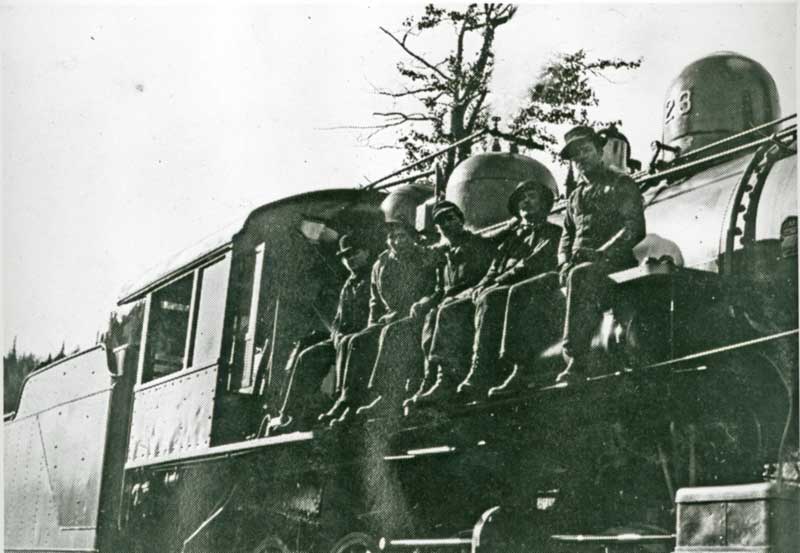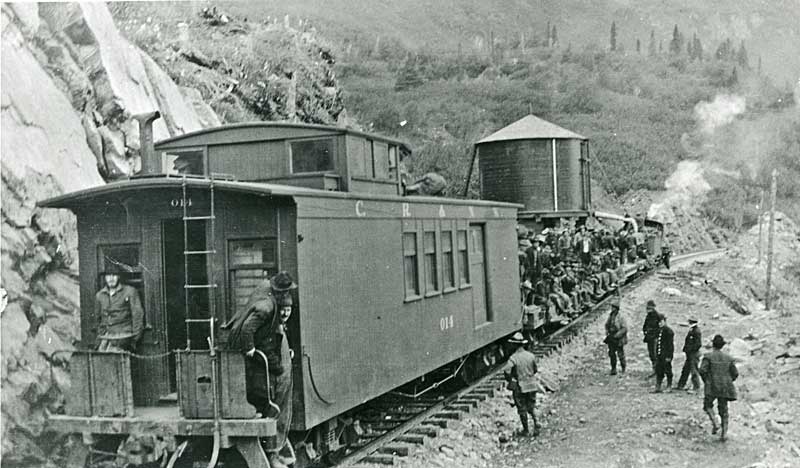 |
Work Train near Strelna
--Van Cleve photo |
It was time to return home. Some track work remained, but section foreman Jack Corey deemed all of the major repairs completed between Long Lake and the Copper River crossing. The three skeel-eh volunteered to be included in the first
lay-off. They would jump a ride on the maintenance engine, consolidation no.21,
when it returned to Chitina for routine oiling in the pit. Charles planned to
help on his mother’s fishwheel, as he did every summer, while Cap and Johnny
needed to prepare themselves for their return to Kennecott. Number 21 was
to head off to Chitina towing only its caboose. Johnny talked engineer Albert
Dalton into letting him ride up front in the locomotive cab. The engine was an
American Locomotives Rhode Island 85 ton consolidation--a 2-8-0. That was the
designation for an engine with eight drive wheels and two leading ones, with no
trailing wheels under the cab and firebox. There were four
of them in the system--20 through 23, built in 1907 with sequential serial
numbers as part of an order of equipment originally destined for China. These
were the most powerful engines on the roster until 1915 when the first Mikados
arrived. Because of their special wheel arrangement, they were best suited to
head the ore trains. The problem was that it normally required two of these
engines hooked up in tandem--a process called “double-heading”--to pull a line
of thirty-five loaded ore cars.

|
CRNW Engine #23: Above:
Gloria Day photo / Below: Percy Conrad photo |
 |
|
|
It soon became
obvious that it would be far more efficient to simply buy newer, more powerful
engines. By 1915 the new Mikado had proven to be a good candidate for this type
of operation. The Mikado was the name for an engine with the 2-8-2 wheel
arrangement. The first engines with this wheel arrangement were built by
Baldwin Locomotive Works for a Japanese railroad company. The ALCO-Brooks model
weighed 95 tons and was equipped with super heaters which made more efficient
use of the steam it generated. The first three of these arrived in 1915 and 1916 just in time for an anticipated jump in
copper production. In that year ore production took a leap from 81,104 tons
requiring 90 trains of thirty cars each for the year to 177,916 tons of ore that
would require 198 trains pulling the same load. The vastly increased mine
output meant the train consists would now require thirty-five loaded flat cars
instead of thirty, just to keep up with the demand. Two more of the Mikados
were added in 1917. With the arrival of the Mikados, the CRNW Railway began
running two distinct trains on the same track. The Mainline,
or Cordova Local, ran from the Alaska Steamship wharf to Chitina. The Chitina
Local was the temporary Bonanza branch line to Kennecott. The company built the
mining branch line to less strict engineering standards than the mainline, using
lighter rail and tighter curves with heavier grades, but overtime the
distinction between the branch line and the mainline was lost. The use of the
concurrent trains doubled the capacity of the line. The trains
would meet in Chitina, switching name designations and continuing on down the
line. The arrangement began in 1916 and continued for the remaining twenty-two
years of railroad operation. It enabled daily service throughout the system as
long as conditions permitted. In 1936 the
boiler on no. 71 blew up while the engine was at the service bay in Chitina,
killing the fireman and seriously burning the engineer. The engine was hauled
back to Cordova and permanently sidelined there, leaving the other four to carry
the load. The fifth Mikado was no longer essential due to the diminished
requirements of mine production. As the four
consolidations were no longer needed for mainline service, they were commonly to
be found running the work trains, including the rotary snow plow consists.
Since all the moguls were now used as switch engines and pushers stationed at
Cordova, Chitina and Shushanna Junction, usually the CRNW used one of the
consolidations for small passenger train consists.

|
CRNW
engine #70, a 2-8-2 Mikado, photographed in Washington in 1940, sold to
the Midland Terminal Railway as #62 in 1940, then to the Nor-Oeste de
Mexicano as #200 in 1948 where it was ultimately scrapped. Built in
1915, one of five similar CRNW engines of the 70-series.
--Charles E. Winters |
The 20-series Rhode Islands were impressive engines with drive wheels that were fifty-six inches tall. The cab was high above the tracks, with a commanding view. Above the long boiler were two large sand domes as well as the huge steam dome. They
were stately and majestic machines, indeed. Finally Johnny
had the ride he had dreamed of since he was ten. he had the engineer’s view from
the cab of one of the great Rhode Island engines. He assisted the fireman, but
was more interested in just watching the a view he could only imagine until now,
as the locomotive worked its way through the lower Chitina River valley. The
mountains to the south and west, like much of the region were dramatic, the
effect enhanced by the relative closeness. It was an
experience beyond anything he could imagine. The effect of seeing all this
mountain scenery from the control deck of the eighty-five ton engine rumbling
with its obviously powerful pistons over the widely-spaced steel rails while
the wind whipped by his face as the engine advanced rapidly down the gentle
slope past Strelna Lake left Johnny beside himself with not a care in the
world. Just behind in
the caboose, Cap was sharing the cupola with Charles. Matt had prepared some of
his famous coffee which both young men were sipping. “Your older
brother’s having the time of his life up there, Charles. He’ll be up the clouds
long after we arrive in Chitina.” “It’s what he’s
always dreamed, Cap. He never could stop talking about the iron horse machines
when he was a kid.” “He still
hasn’t stopped. He says less, but never stops admiring them. They seem to take
him out there somewhere no one can see.” Down below
Kay-yew-nee was studying the conductor. The boys had left the dog behind at
Chitina, but the Siberian mutt had worked his way up the tracks, finding Johnny
and Cap two days later. He was not about to be left out. Cap was considering
this problem of having the dog follow them all the way up the line to Kennecott,
where he would no doubt be shot.

|
CRNW
caboose & work crew somewhere south of Chitina --Cordova
Museum |
|
1 comment:
Ron, I love your contributions to CR&NW history. I would like to make contact about the info you have about this railroad. Steve
Post a Comment